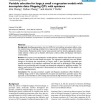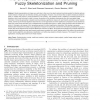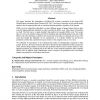954 search results - page 183 / 191 » A Modular Approach to Packet Classification: Algorithms and ... |
BMCBI
2008
13 years 7 months ago
2008
Background: Identifying quantitative trait loci (QTL) for both additive and epistatic effects raises the statistical issue of selecting variables from a large number of candidates...
AI
2002
Springer
13 years 7 months ago
2002
Springer
Neural network ensemble is a learning paradigm where many neural networks are jointly used to solve a problem. In this paper, the relationship between the ensemble and its compone...
PAMI
2010
13 years 6 months ago
2010
—Medial representations of shapes are useful due to their use of an object-centered coordinate system that directly captures intuitive notions of shape such as thickness, bending...
CLEF
2007
Springer
14 years 1 months ago
2007
Springer
This paper describes the participation of MIRACLE research consortium at the ImageCLEF Medical Image Annotation task of ImageCLEF 2007. Our areas of expertise do not include image...
BMCBI
2004
13 years 7 months ago
2004
Background: Hidden Markov Models (HMMs) have proven very useful in computational biology for such applications as sequence pattern matching, gene-finding, and structure prediction...



